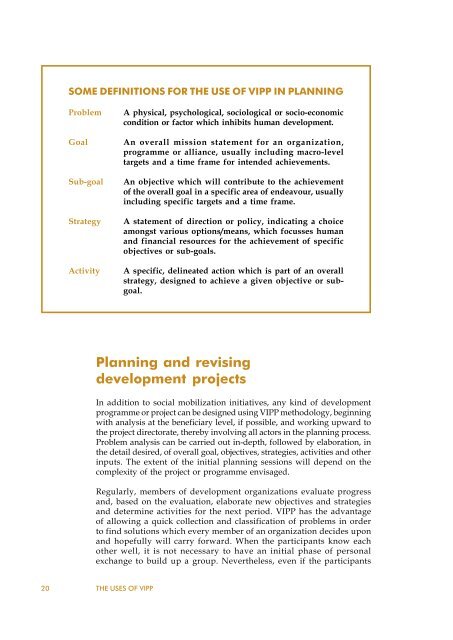VIPP_Unicef
VIPP_Unicef
VIPP_Unicef
Create successful ePaper yourself
Turn your PDF publications into a flip-book with our unique Google optimized e-Paper software.
20<br />
SOME DEFINITIONS FOR THE USE OF <strong>VIPP</strong> IN PLANNING<br />
Problem A physical, psychological, sociological or socio-economic<br />
condition or factor which inhibits human development.<br />
Goal An overall mission statement for an organization,<br />
programme or alliance, usually including macro-level<br />
targets and a time frame for intended achievements.<br />
Sub-goal An objective which will contribute to the achievement<br />
of the overall goal in a specific area of endeavour, usually<br />
including specific targets and a time frame.<br />
Strategy A statement of direction or policy, indicating a choice<br />
amongst various options/means, which focusses human<br />
and financial resources for the achievement of specific<br />
objectives or sub-goals.<br />
Activity A specific, delineated action which is part of an overall<br />
strategy, designed to achieve a given objective or subgoal.<br />
Planning and revising<br />
development projects<br />
In addition to social mobilization initiatives, any kind of development<br />
programme or project can be designed using <strong>VIPP</strong> methodology, beginning<br />
with analysis at the beneficiary level, if possible, and working upward to<br />
the project directorate, thereby involving all actors in the planning process.<br />
Problem analysis can be carried out in-depth, followed by elaboration, in<br />
the detail desired, of overall goal, objectives, strategies, activities and other<br />
inputs. The extent of the initial planning sessions will depend on the<br />
complexity of the project or programme envisaged.<br />
Regularly, members of development organizations evaluate progress<br />
and, based on the evaluation, elaborate new objectives and strategies<br />
and determine activities for the next period. <strong>VIPP</strong> has the advantage<br />
of allowing a quick collection and classification of problems in order<br />
to find solutions which every member of an organization decides upon<br />
and hopefully will carry forward. When the participants know each<br />
other well, it is not necessary to have an initial phase of personal<br />
exchange to build up a group. Nevertheless, even if the participants<br />
THE USES OF <strong>VIPP</strong>


